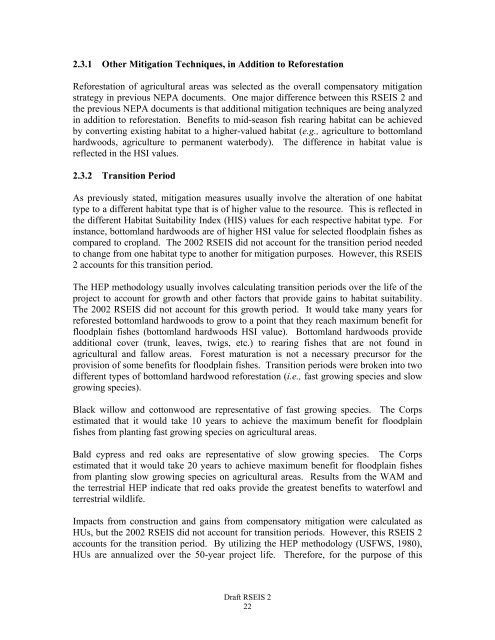St. Johns/New Madrid RSEIS - Endangered Species & Wetlands ...
St. Johns/New Madrid RSEIS - Endangered Species & Wetlands ...
St. Johns/New Madrid RSEIS - Endangered Species & Wetlands ...
You also want an ePaper? Increase the reach of your titles
YUMPU automatically turns print PDFs into web optimized ePapers that Google loves.
2.3.1 Other Mitigation Techniques, in Addition to Reforestation<br />
Reforestation of agricultural areas was selected as the overall compensatory mitigation<br />
strategy in previous NEPA documents. One major difference between this <strong>RSEIS</strong> 2 and<br />
the previous NEPA documents is that additional mitigation techniques are being analyzed<br />
in addition to reforestation. Benefits to mid-season fish rearing habitat can be achieved<br />
by converting existing habitat to a higher-valued habitat (e.g., agriculture to bottomland<br />
hardwoods, agriculture to permanent waterbody). The difference in habitat value is<br />
reflected in the HSI values.<br />
2.3.2 Transition Period<br />
As previously stated, mitigation measures usually involve the alteration of one habitat<br />
type to a different habitat type that is of higher value to the resource. This is reflected in<br />
the different Habitat Suitability Index (HIS) values for each respective habitat type. For<br />
instance, bottomland hardwoods are of higher HSI value for selected floodplain fishes as<br />
compared to cropland. The 2002 <strong>RSEIS</strong> did not account for the transition period needed<br />
to change from one habitat type to another for mitigation purposes. However, this <strong>RSEIS</strong><br />
2 accounts for this transition period.<br />
The HEP methodology usually involves calculating transition periods over the life of the<br />
project to account for growth and other factors that provide gains to habitat suitability.<br />
The 2002 <strong>RSEIS</strong> did not account for this growth period. It would take many years for<br />
reforested bottomland hardwoods to grow to a point that they reach maximum benefit for<br />
floodplain fishes (bottomland hardwoods HSI value). Bottomland hardwoods provide<br />
additional cover (trunk, leaves, twigs, etc.) to rearing fishes that are not found in<br />
agricultural and fallow areas. Forest maturation is not a necessary precursor for the<br />
provision of some benefits for floodplain fishes. Transition periods were broken into two<br />
different types of bottomland hardwood reforestation (i.e., fast growing species and slow<br />
growing species).<br />
Black willow and cottonwood are representative of fast growing species. The Corps<br />
estimated that it would take 10 years to achieve the maximum benefit for floodplain<br />
fishes from planting fast growing species on agricultural areas.<br />
Bald cypress and red oaks are representative of slow growing species. The Corps<br />
estimated that it would take 20 years to achieve maximum benefit for floodplain fishes<br />
from planting slow growing species on agricultural areas. Results from the WAM and<br />
the terrestrial HEP indicate that red oaks provide the greatest benefits to waterfowl and<br />
terrestrial wildlife.<br />
Impacts from construction and gains from compensatory mitigation were calculated as<br />
HUs, but the 2002 <strong>RSEIS</strong> did not account for transition periods. However, this <strong>RSEIS</strong> 2<br />
accounts for the transition period. By utilizing the HEP methodology (USFWS, 1980),<br />
HUs are annualized over the 50-year project life. Therefore, for the purpose of this<br />
Draft <strong>RSEIS</strong> 2<br />
22
















